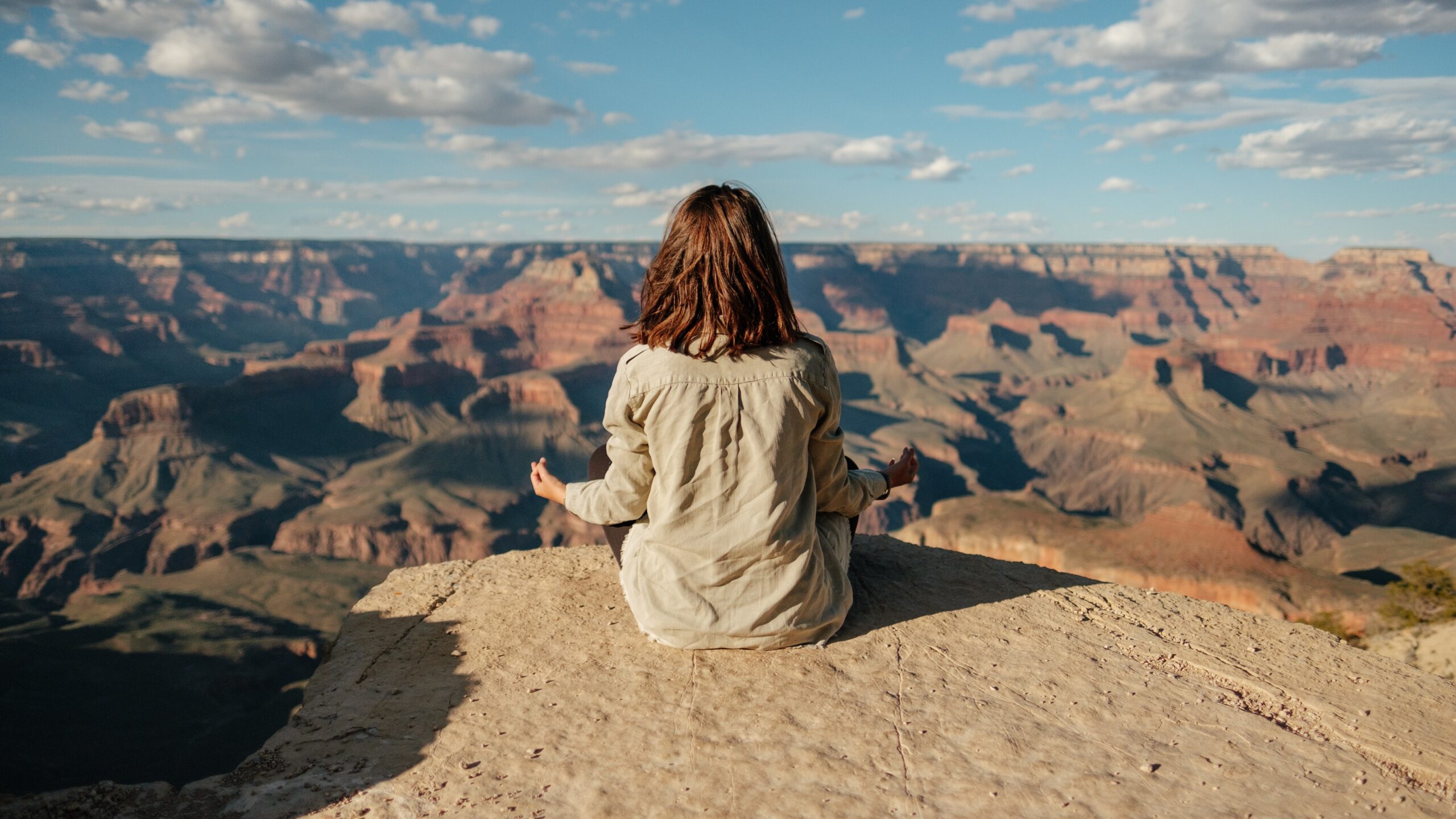Before diving into how to do unguided meditation, let us first look briefly at what meditation is.
What is Meditation?
It is a set of methods to promote increased awareness and concentrated attention using mental and physical techniques.
Meditation is an element of many spiritual traditions’ teachings and practices, but it is independent of any religion or belief. It is used in many cultures today to promote inner harmony, tranquility, and quiet.
Meditation also helps to reduce stress and minimize symptoms of anxiety and depression. It also enhances your capacity to adjust to and get through emotional problems.
Guided Vs Unguided Meditation
Guided Meditation
In guided meditation, an instructor walks you through the fundamental techniques. Guided meditation benefits beginners because they can follow the teacher’s advice and get the most out of the experience. Most guided meditations have the same structure: the instructor explains how the mind works during meditation, guides you through a specific meditation technique, and then offers suggestions for applying that skill to your daily life.
Unguided Meditation
It is also known as silent meditation. It is done alone without the involvement of a teacher or a meditation expert. The unguided meditation technique simply entails sitting quietly and focusing on the body and thoughts for a set period. It is a very effective approach to connecting with your inner peace. Engaging in unguided meditation creates a space where you can find renewal, tranquility, and enlightenment. However, many beginners who attempt unguided meditation cannot maintain their focus on the task and frequently become distracted by intruding thoughts.
How to Do Unguided Meditation
Since you do not require a teacher or instructor to walk you down the unguided meditation process, you can start doing it whenever you feel you need to. Similarly, you can choose to focus on anything you want – your thoughts, breath, or emotions.
The most basic method of unguided attention involves focusing on your breath.
Take a deep breath to begin. The goal of unguided meditation is to learn to detect when thoughts enter your mind and let them pass without reacting. It is not to entirely clear your mind. Concentrate on your breathing; whenever a thought enters, notice it before letting it go by returning your attention to your breath.
What Are the Types of Unguided Meditation?
Mindfulness Meditation
It enables you to create a state of mind where you are entirely present in the now, allowing you to accept and acknowledge your thoughts, feelings, and sensations without passing judgment.
Spiritual Meditation
This type of meditation connects you to your spirit. It leads you further into who you truly are, beyond limiting identities and titles. It makes you realize the everlasting truth and helps you let go of everything that has happened and will happen in the future.
Focused Meditation
It involves paying close attention to a single stimulus like sounds, sights, textures, tastes, scents, and even your breathing to help you stay in the now and quiet your mind.
Movement Meditation
It includes moving mindfully and slowly through the various positions. Instead of concentrating on the purpose of the activity, it focuses on the body’s movements. You start to pay attention to numerous body regions you usually ignore, such as your elbow, cheek, or hip. You become aware of how your body feels as it moves, bends, and twists. When you are aware of your body, you will be able to notice your breathing, heartbeat, and other internal sensations more easily.
Mantra Meditation
It involves repeatedly chanting a mantra – a word, syllable, or phrase. Mantras can be said aloud, chanted, murmured, or mentally repeated. It promotes better self-awareness, lessens tension, and bestows a calmer state of mind.
Reflection Meditation
It helps you focus on a topic until your mind is exhausted and you are open to receiving ideas from your superconscious. New ideas and knowledge might emerge, adding to your internal hard drive’s data stores. Your perceptions and viewpoint can change due to the mind’s capacity to incorporate information.
Visualization
It requires you to focus on imagery to develop mindfulness. It aids practitioners in developing radical acceptance, expressing gratitude, and accomplishing their objectives.
Yoga Meditation
It combines the health advantages of yoga practice with the spirit of meditation. It helps you improve your general well-being and mental health. These techniques ultimately aim to make you feel calm, at ease, self-aware and connected to the cosmos by regulating and concentrating on your breath.
Chakra Meditation
Chakra meditation is purposeful access to a chakra’s potent energy or clearing a chakra blockage. You can experience a sensation of inner serenity, equilibrium, and relaxation by completely opening your chakras during a meditation session.
Body Scan
It involves looking for tension, tightness, pain, or anything unusual in your body. When practicing body scan meditation, you mentally scan your entire body in a steady, deliberate motion from the bottom of your feet to the top of your head. You may acquire insight into your emotions and ideas by becoming aware of where you retain your stress and tension in your body.
How to Transition from Guided to Unguided Meditation

Guided meditation provides a wonderful and more straightforward entry point into the world of meditation since someone guides. It directs you to help you move into relaxation and prepare for the deeper stages of meditation.
However, once you’ve been meditating for a while and want to explore your inner space, guided meditations can frequently only take you so far. It may be due to the risk of being dependent on a voice directing something external to you rather than giving in to your divine nature and allowing that energy to lead you into profound meditation.
It initially may require more practice, particularly when it comes to focusing your attention and remaining in the present moment. After some practice, you can sit in meditation without the aid of a teacher or guide. Like anything you often do, you begin to develop muscle memory and can frequently start to connect in less time.
You can let go of a technique once you feel connected to it. You can recognize when you’ve wandered and then return to it.
Being fully present with yourself in each moment allows you to tune into that divine energy, heighten your awareness of your inner space, enter a deep state of surrender and calm, and enable the power of meditation to lead you. Any external stimuli are distractions from your meditation, or you are so absorbed in it that you are unaware of them when you are in the most profound state of meditation.
The Ending Note
There are benefits to both directed and unguided meditation practices. The key is always to be curious and eager to learn more about an experience. Unguided meditation allows you to connect to the divine spirit that will guide you. Once you master this technique, you may rely on this energy to flow with you in everyday life. It is a crucial component of meditation.
FAQs
How do I start unguided meditation?
You do not need a guide for it. Start by paying attention to anything you want. Most people focus on their breath. Take a deep breath. Unguided meditation teaches you to recognize when thoughts come to mind and to let them go without reacting. Keep your focus on your breathing; if a thought comes to mind, acknowledge it before letting it go by bringing your focus back to your breath.
Is unguided meditation better?
The goal of meditation is to still the mind, find calm, and delve inside. Guided meditations train the mind to depend on outside stimuli. When you train your mind to associate calm with an external sound, such as someone’s voice or direction, it becomes more challenging to go within. So, guided mediation is, indeed, better.
How can I meditate without guided meditation?
You can opt for unguided meditation. You can do it without the assistance of a teacher. It involves simply sitting quietly and concentrating on the body and thoughts for a specific time. It is a highly efficient method for finding inner calm.
Does meditation work if you have ADHD?
Meditation may sound intimidating to someone with ADHD, but research has shown that mediation helps manage ADHD symptoms. A 2015 study reported that mindful meditation improves mood, attention, and quality of life in ADHD adults.
Can I meditate lying down?
You might feel too relaxed when you lie down and fall asleep. The best way to meditate is while sitting. It offers the ideal combination of concentration and relaxation. Both the body and the mind remain awake and focused when the body is upright. A certain amount of relaxation and letting go when you are seated. However, you can lie down if you’re in too much discomfort.
Is meditation allowed in Christianity?
No particular religion has exclusive rights to meditation. When you meditate as a Christian, you become still, listen to God, and sense His presence. By calming the chattering mind, which is only a collection of thoughts and ideas, you can travel into your consciousness and connect to God’s consciousness.
What is the most effective meditation technique?
Classifying meditation practices as more or less effective than others is probably not feasible. You must find a meditation practice that accommodates your needs. Different meditation practices confer various benefits and call for various abilities and perspectives. Read this article’s section titled ‘What are the different types of meditation practices?’ to learn more about the multiple types of meditation practices. When a meditation style makes you feel comfortable and encouraged, you know it suits you.
How can I meditate on my own?
To meditate on your own, you can do unguided meditation. All you have to do is sit still and concentrate on the body and thoughts for a specific time. You can use a timer or a smartphone app to start your unguided meditation session, and you can end it when the timer goes off. Additionally, you can count your breaths as you take them to track how many you take, and when you reach the desired number, end your meditation session.

